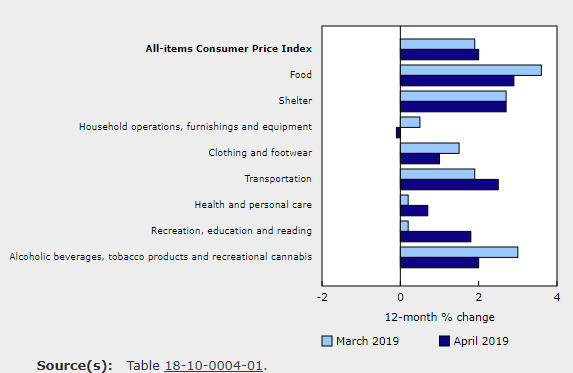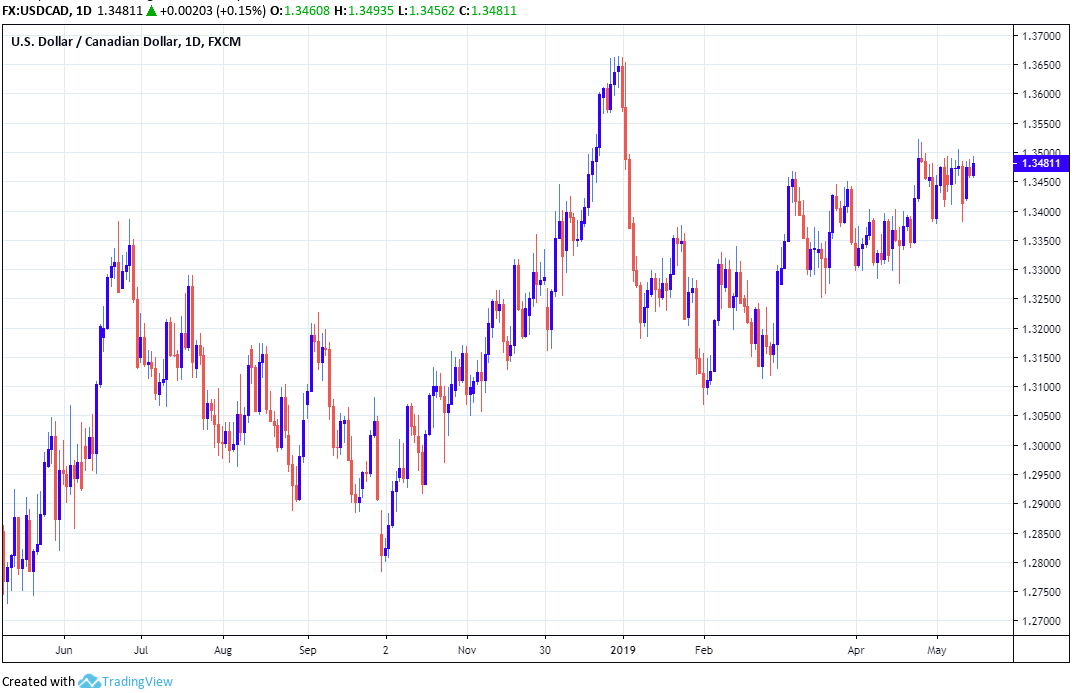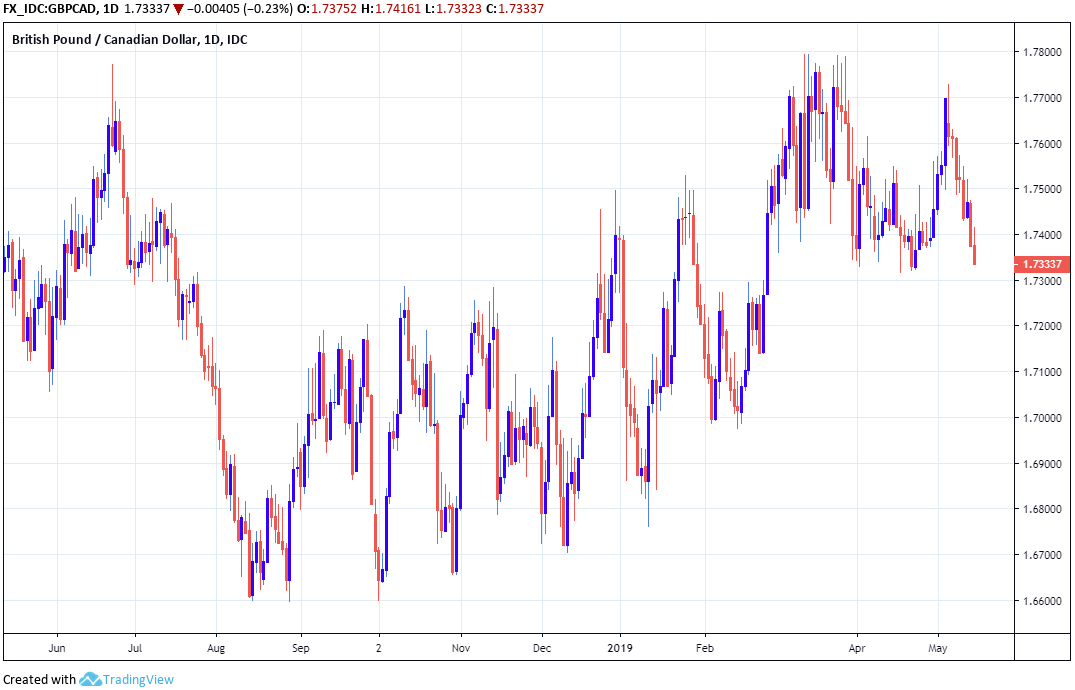Canadian Dollar Covers Up as Core-inflation Cools and Global Growth Fears Abound
- Written by: James Skinner
-

Image © Bank of Canada
- CAD softens amid inflation disappointment, global growth fears.
- Underlying inflation dips below target, leaving the BoC firmly on hold.
- Morgan Stanley forecasts a steep USD/CAD fall, as CIBC aims for 1.40.
- Pound-to-Canadian-Dollar rate eyes post-referendum high for year-end.
The Canadian Dollar was on the defensive Wednesday after official data showed domestic inflation pressures moderating in April and as fears for the global growth outlook mounted further, but Morgan Stanley says there are brighter days ahead for the currency.
Statistics Canada data shows Canadian inflation rose by 0.4% in April which, although down from 0.7% previously, was in line with market expectations and enough to push the annualised rate of price growth up from 1.9% to 2%.
But the message coming from Canada's three various measures of core inflation, which aim to provide a truer reflection of underlying inflation pressures by excluding different kinds of items from the various measures, was negative.
Those core measures were expected to continue averaging the 2% level in April, but the average slipped to 1.9%. The headline number is bang on the midpoint of the Bank of Canada (BoC) 1%-to-3% target range, but the more important average of the three core measures has now slipped beneath it.
"Inflation in Canada is just a steady as she goes story, and she goes right in line with the Bank of Canada's target. That's true for the headline 2.0% rate, and nearly so for the three core measures that average only a tick lower at 1.9%. There's nothing for markets to really chew on today, with the date essentially bang on expectations, and with the headline figure only a tick higher than the prior month and showing no obvious trend," says Avery Shenfeld, chief economist at CIBC Capital Markets.

Above: Contributions to Canadian inflation in April. Source: Statistics Canada.
Markets care about the inflation data because it is the outlook for consumer price pressures that dictates central bank interest rate policies, and its changes in the relative interest rate outlook which drive the capital flows that government movements in exchange rates.
Above-target inflation, and signs that price pressures are building from any level, often get markets contemplating the odds of whether an interest rate hike is on the horizon and lift the Canadian Dollar a lift. But the opposite is also true.
Interest rate decisions impact currencies through the influence they have over capital flows, as well as their allure for short-term speculators, which tend to move in the direction of the most advantageous or improving returns.
"While low pump prices around the turn of the year are now a distant memory, there was some good news for consumers in today’s CPI report. Core inflation remained steady at 2%, giving the Bank of Canada plenty of leeway to hold interest rates steady (and watch other developments, like rising global trade tensions). For households, that means less of an increase in debt service costs than was seen last year," says Josh Nye, an economist at RBC Capital Markets.

Above: USD/CAD rate shown at daily intervals.
The USD/CAD rate was quoted 0.18% higher at 1.3485 following the release but is down -0.82% for 2019, while the Pound-to-Canadian-Dollar rate was -0.21% lower at 1.7336 and has fallen -0.39% this year.
"Global sentiment was trying to make a turnaround back to the topside into Wednesday, in reaction to a softer, more encouraging round of White House rhetoric on trade with China. However, today’s softer China retail sales and industrial production prints are reminding investors about other downside risks," says Joel Kruger, a strategist at LMAX Exchange.

Above: Pound-to-Canadian-Dollar rate shown at daily intervals.
"Fundamentally, we’ve liked being short CAD for a while, and now technically the stars are aligning for long USD/CAD as the setup is too strong to ignore," says Bipan Rai, head of FX strategy at CIBC, in a note sent to clients after the April BoC meeting. "Weekly charts point to a USD/CAD extension higher, possibly towards the 1.40 mark into the medium-term."
The Bank of Canada left its overnight rate unchanged at 1.75% in April and warned that risks to the Canadian economy are higher than many had appreciated, given transportation and storage limits in the domestic energy sector and "trade tensions" between the U.S. and other countries, which have stepped up again in recent weeks.
Those concerns, and the outlook for the global economy, explain why the BoC about-turned in December on earlier guidance that had suggested it could lift its interest rate as many as three or four times in 2019. Its guidance now is that rates could go up or down in the next change.
The BoC u-turn took several months to carry off but is now complete, although the USD/CAD rate is up from the 1.32 level it was at before the pivot and the Pound-to-Canadian-Dollar rate has risen from 1.67.

Above: Foreign portfolio inflows into Canada. Source: Morgan Stanley.
Many analysts including those at CIBC are forecasting further losses for the Loonie in 2019, but the team at Morgan Stanley says the Canadian currency may have enough juice left in the tank for one last rally higher this year before succumbing to fresh weakness in the longer-term.
"CAD may gain modestly in the coming months, with USDCAD falling to 1.30 by year end, though structural challenges keep us long-term bearish. An environment of a global growth rebound, modestly firming oil prices,and a domestic economic recovery should keep CAD on a modestly strengthening trend, particularly as the USD softens," says Hans Redeker, head of FX strategy at Morgan Stanley.
Redeker also says the Canadian Dollar will need to remain weak in the long-term, and USD/CAD rise, if the country is to be able to attract the international capital required to support government spending, consumption and investment.
That's similar to the view held by Canada's CIBC Capital Markets, where both Shenfeld and Rai have said the currency will need to weaken materially over the coming years in order to keep the nation funded and the economy growing.
Morgan Stanley's 1.30 forecast for USD/CAD at year-end has been lifted from the 1.28 it was looking for at the beginning of 2019. The Pound-to-Canadian-Dollar rate is projected to rise to 1.79 before the curtain closes on 2019.
Time to move your money? Get 3-5% more currency than your bank would offer by using the services of foreign exchange specialists at RationalFX. A specialist broker can deliver you an exchange rate closer to the real market rate, thereby saving you substantial quantities of currency. Find out more here.
* Advertisement









